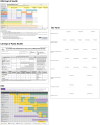Design of patient-facing immunization visualizations affects task performance: an experimental comparison of 4 electronic visualizations
- PMID: 38833256
- PMCID: PMC11491626
- DOI: 10.1093/jamia/ocae125
Design of patient-facing immunization visualizations affects task performance: an experimental comparison of 4 electronic visualizations
Abstract
Objective: This study experimentally evaluated how well lay individuals could interpret and use 4 types of electronic health record (EHR) patient-facing immunization visualizations.
Materials and methods: Participants (n = 69) completed the study using a secure online survey platform. Participants viewed the same immunization information in 1 of 4 EHR-based immunization visualizations: 2 different patient portals (Epic MyChart and eClinicWorks), a downloadable EHR record, and a clinic-generated electronic letter (eLetter). Participants completed a common task, created a standard vaccine schedule form, and answered questions about their perceived workload, subjective numeracy and health literacy, demographic variables, and familiarity with the task.
Results: The design of the immunization visualization significantly affected both task performance measures (time taken to complete the task and number of correct dates). In particular, those using Epic MyChart took significantly longer to complete the task than those using eLetter or eClinicWorks. Those using Epic MyChart entered fewer correct dates than those using the eLetter or eClinicWorks. There were no systematic statistically significant differences in task performance measures based on the numeracy, health literacy, demographic, and experience-related questions we asked.
Discussion: The 4 immunization visualizations had unique design elements that likely contributed to these performance differences.
Conclusion: Based on our findings, we provide practical guidance for the design of immunization visualizations, and future studies. Future research should focus on understanding the contexts of use and design elements that make tables an effective type of health data visualization.
Keywords: child; data visualization; health records; patient portals; personal; vaccination.
© The Author(s) 2024. Published by Oxford University Press on behalf of the American Medical Informatics Association.
Conflict of interest statement
None declared.
Figures
Similar articles
-
Willingness to Be Contacted via a Patient Portal for Health Screening, Research Recruitment, and at-Home Self-Test Kits for Health Monitoring: Pilot Quantitative Survey.JMIR Form Res. 2024 Nov 22;8:e59837. doi: 10.2196/59837. JMIR Form Res. 2024. PMID: 39584575 Free PMC article.
-
The effect of two different electronic health record user interfaces on intensive care provider task load, errors of cognition, and performance.Crit Care Med. 2011 Jul;39(7):1626-34. doi: 10.1097/CCM.0b013e31821858a0. Crit Care Med. 2011. PMID: 21478739 Clinical Trial.
-
Online patient websites for electronic health record access among vulnerable populations: portals to nowhere?J Am Med Inform Assoc. 2017 Apr 1;24(e1):e47-e54. doi: 10.1093/jamia/ocw098. J Am Med Inform Assoc. 2017. PMID: 27402138 Free PMC article.
-
A Systematic Review of Patient-Facing Visualizations of Personal Health Data.Appl Clin Inform. 2019 Aug;10(4):751-770. doi: 10.1055/s-0039-1697592. Epub 2019 Oct 9. Appl Clin Inform. 2019. PMID: 31597182 Free PMC article.
-
Using Electronic Health Record Portals to Improve Patient Engagement: Research Priorities and Best Practices.Ann Intern Med. 2020 Jun 2;172(11 Suppl):S123-S129. doi: 10.7326/M19-0876. Ann Intern Med. 2020. PMID: 32479176 Free PMC article.
Cited by
-
Reflections on interactive visualization of electronic health records: past, present, future.J Am Med Inform Assoc. 2024 Nov 1;31(11):2423-2428. doi: 10.1093/jamia/ocae249. J Am Med Inform Assoc. 2024. PMID: 39429003 No abstract available.
References
-
- HealthIT.gov. ONC’s Cures Act Final Rule. Accessed January 2023. https://www.healthit.gov/topic/oncs-cures-act-final-rule
-
- Minnesota Health Care Programs (MHCP) Immunization and Vaccination program. Immunization Record Form—MN Department of Health. Accessed January 2023. https://www.health.state.mn.us/people/immunize/basics/kids.html
-
- California Department of Public Health Immunization Branch. California School Immunization Record. Accessed January 2023. https://www.cdph.ca.gov/Programs/CID/DCDC/Pages/Immunization/School/reso...
-
- Centers for Disease Control and Prevention (CDC) Advisory Committee on Immunization Practices. CDC Child and Adolescent Immunization Schedule. Accessed January 2023. https://www.cdc.gov/vaccines/schedules/hcp/imz/child-adolescent.html
Publication types
MeSH terms
Grants and funding
LinkOut - more resources
Full Text Sources
Medical



